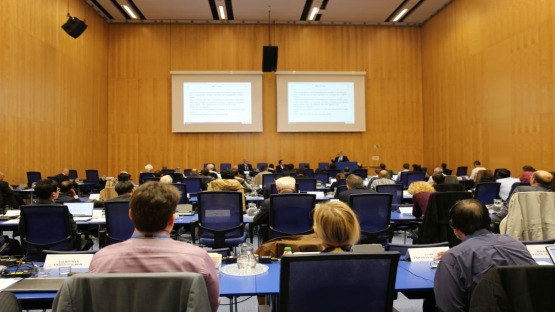Experts assessing the safety of a nuclear power plant (NPP) with multiple reactors must look at the site from a bird’s eye view, carefully considering how an accident damaging one element of a plant could impact the entire site. The IAEA has developed a methodology based on best practices to help experts do exactly this, which was discussed in a meeting attended by over 70 participants from 29 countries last week in Vienna.
Risk assessments for NPPs with multiple reactors – known as multi-unit probabilistic safety assessments (MUPSAs) – are used to help improve plant safety in case of a multi-unit accident and are required by regulators in certain countries. However, these complex assessments are challenging to conduct. The IAEA has developed and tested a methodology to ease the process by providing step-by-step guidance to experts on conducting a MUPSA.
“The [MUPSA] methodology provides a useful tool for addressing risks specifically related to multi-unit accidents. It has been tested in a realistic and complex case study. The next step is publishing a safety report to document the methodology and disseminate insights from the case study and current international practice,” said IAEA Deputy Director General Juan Carlos Lentijo, Head of the Department of Nuclear Safety and Security, in his opening remarks.
Meeting participants provided input on the first draft of this safety report, which is expected to be released by the end of 2020. Their feedback is crucial to ensure that the final report is useful to national authorities conducting safety assessments at multi-unit sites, Lentijo said.
Increase in multi-unit nuclear power plants
Over two-thirds of all NPPs have more than one reactor unit, some with as many as seven or eight per site. The number of multi-unit NPPs is likely to increase due to a rise in energy demands and the challenges often encountered in establishing new sites for NPPs, incentivizing the use of existing ones when constructing new reactors.
Each multi-unit NPP faces hazards that can create event sequences in the plant, which under extreme conditions may lead to core damage in one or more reactors and pose a threat to overall site safety. These include natural disasters, such as tsunamis or earthquakes, and internal fires and floods caused by human error or hardware faults.
The MUPSA methodology helps experts to analyse these hazards and possible accident sequences. This highlights the strengths and weaknesses of a plant’s safety functions in case of a multi-unit accident, said George Apostolakis, Meeting Chair and Head of Japan’s Nuclear Risk Research Center. “Understanding this picture allows decision makers to take action to improve certain aspects of plant safety if needed,” he added.
Understanding the big picture
Additionally, the MUPSA methodology takes a plant’s design and operation into consideration, paying special attention to any shared elements. Reactors at multi-unit plants typically share an electrical grid and may share other structures, systems and components that provide vital safety functions, such as an emergency supply of water used to cool a reactor if it overheats.
These shared systems can be both beneficial and disadvantageous during an accident, said Marina Röwekamp, Chair of the Working Group on Risk Assessment at the Nuclear Energy Agency (NEA) of the Organisation for Economic Co-operation and Development (OECD). “The MUPSA methodology can, for example, help countries to investigate and assess multi-unit site designs, covering both the positive and potentially negative aspects of shared systems in a balanced way,” she said.
At present the MUPSA methodology has only been tested on hypothetical event sequences that could lead to core damage in a reactor. Participants discussed expanding the case study in the future to examine conditions that can pose a challenge to the containment response and their potential environmental and health effects. They also explored applications to a site with multiple small modular reactors.
“Ultimately, this methodology will help decision makers see where to focus their resources within a plant to get the most benefit in terms of safety and cost efficiency,” said Apostolakis.




